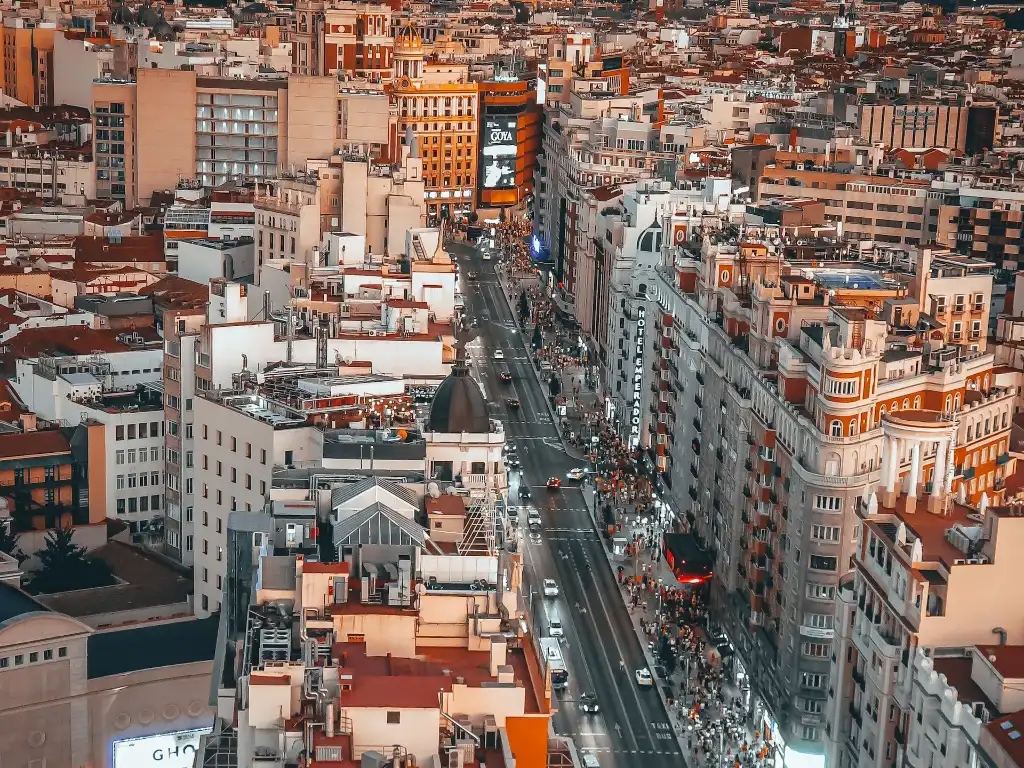
Madrid: The Sunny Spanish City That Merges Tradition and Reinvention
Madrid is a city of juxtaposition. Shrunken abuelos leisurely read the paper on park benches in front of opulent new hotels. Street art created by local legends can be found just around the corner from Picasso’s La Guernica. Workers at the neighborhood’s newest gay bar are busy preparing for the evening rush while just across the way, a decades-old shop is locking its doors in preparation for an afternoon siesta and the tiny bar next door serves up 100-year-old sherry.
Spain’s capital city has been this way—old but new—for centuries. Despite dating back to the year 865, Madrid only became the capital in the 16th century, which makes it relatively young for a European capital city. Then and now, Madrid is a destination where age-old traditions shape everyday life as the city simultaneously unfolds with newness. It’s this combination of tradition and innovation that may just surprise you.
History down every alley
Spain’s social and economic growth throughout the 20th century was heavily influenced by Francisco Franco, the Spanish dictator who ruled from 1939–1975. Madrid, smack in the center of Spain, felt the effects in particular. Because of the city’s isolation, very few influences wove their way into Madrid’s cuisine, culture, and lifestyle, and that held true until only recently.
Still, reminders of Madrid’s past, both positive and negative, wait around every corner. Casa Botín, founded in 1725 and considered to be the oldest restaurant in the world in continuous operation, still serves traditional Spanish fare like roast suckling pig, heaping plates of cured ham and local cheese, and crispy fried croquettes just down the street from Plaza Mayor. Nearby, Plaza de la Villa is one of the oldest squares in Madrid, featuring various buildings erected in the 15th century.
Located a little over one mile on foot (two miles by car) from Plaza de la Villa, the Puerta de Alcalá stone arch that towers over Retiro Park is covered in shrapnel damage from the Spanish Civil War, which lasted from 1936–1939. Madrid’s longstanding visual reminders showcase everything—the good and the bad—that the city and its people have withstood over the years.

Old, meet new
Post-dictatorship, Madrid experienced a cultural and social revolution: La Movida Madrileña. Think 1980s, Spanish-style counterculture, and rock ‘n’ roll. This paved the way for Madrid to become a gastronomic and cultural hub, complete with a thriving music, art, and LGBTQ+ scene. Many locals argue that the movement hasn’t ended or even reached its peak.
Culture isn’t the only thing that’s booming in Madrid. Other industries, like tourism, are thriving. Luxury hotel brands such as the Four Seasons, Mandarin Oriental Ritz, Rosewood, Thompson, JW Marriott, EDITION, and Ocean Drive have all opened new locations in the Spanish capital since 2020.
And when it comes to Madrid’s cuisine, it’s just as easy to find sushi spots, Peruvian ceviche, and Indian restaurants as it is Spanish fare nowadays. According to a study by Delectatech, 34% of the restaurants in Madrid feature international food, when years back, your only option for a hamburger might have been McDonald's.
The city’s dedication to maintaining tradition while also welcoming—and even encouraging—novelty makes it an exciting and vibrant place to visit and live.

To siesta or not to siesta
Not all locals partake in this age-old napping tradition, but you might want to.
Historically, Madrid’s lack of air conditioning, intense sun and heat, and long hours of daylight meant shops and businesses closed around 2–5pm for lunch and a rest. Considering Madrid is Europe’s sunniest capital with more than 300 days of sunshine each year and it stays light until around 10pm during the summer, it’s easy to see why residents and visitors alike opt to partake in the afternoon snooze.
These days, many larger stores—like department stores and chain shops—remain open, but you may notice that family-owned or smaller shops still shut their doors mediodía (midday).
Do as the Spanish do and take a leisurely lunch or proper rest midday. Skip it and you may not last until the late hours of Spanish dinnertime—or long enough to enjoy the city’s wild nightlife, which often doesn’t kick start until after midnight and can last until 6am.

Tapas on tap
In Spain, many locals have a light breakfast around 8am, along with coffee throughout the morning. Lunch is the largest meal of the day, usually around 2 or 3pm. And after a hearty lunch, you may need that siesta, especially since dinner is late, usually around 9 or 10pm.
Around the city, you can expect to find Spanish restaurants serving traditional food, such as tapas, Spanish omelet, and ham. You’ll know you’re at a really local place if you’re offered a free tapa when you order a drink. Tapas range from tostas (small pieces of bread with meat, cheese, or other toppings) to plates of olives and small portions of rice. Be sure to try some of Madrid’s specialties, like cocido, which is a garbanzo stew, or huevos rotos, which are runny eggs over potatoes topped with ham or chorizo.
Want to enjoy food like the Spanish do? Don’t grab takeout or a coffee to-go. Sit down with friends and savor your meal. Whether you’re looking to enjoy a set lunch menu, hop from tapas bar to tapas bar, or leisurely sip vino on an outdoor terrace beneath the Spanish sun, drinking and dining is one of the best ways to enjoy the capital’s buzzing energy.

Art fit for kings and queens
Madrid is a cultural epicenter thanks to the Golden Triangle of Art: the Prado, Reina Sofía, and Thyssen-Bornemisza museums. These three iconic museums, located a short stroll apart, feature works from artists like Picasso and Velázquez.
You can also get your fix at dozens of other museums, like fashion at the Museo del Traje or textiles at the Royal Tapestry Factory. Each museum is spectacular in its own right, but if you’re worried that you won’t be able to see it all, prioritize Goya at the Prado and Dalí at the Reina Sofía.
Madrid’s creativity isn’t reserved for the Prados and Reina Sofías of the city, though. It’s on display outdoors, too, especially along the Paseo de Prado, deemed a UNESCO site thanks to its outstanding landscape. But it’s gorgeous even if you’re just going for a stroll. Admire the art deco architecture along the busy Gran Vía, colorful street art murals in Malasaña, and hundreds of statues dotting the city. Don’t miss Botero’s oversized lady in Colón, the 44 stone statues of kings that line the Plaza de Oriente, or the Quadriga, a rooftop statue of four horses and a man on Calle Alcalá.

Not your average Picasso
Already hit the Prado? For something a little different, check out Madrid’s quirkier attractions, like the Egyptian Temple of Debod, which dates back to the 2nd century BC. Built in Aswan, Egypt gave it to Madrid as a gift in 1968. The temple was disassembled, transported stone-by-stone, and rebuilt in Madrid on the edge of Oeste Park.
Nearby, glide across Madrid’s red roofs and treetops on the Teleférico, Madrid’s cable car, to Casa de Campo, the city’s largest park at 4,200 acres. Check out the Kilometer 0 plaque in Puerta del Sol, which is considered the geographical center of Spain and the spot from which all the roads head outward—they moved the capital here for a reason!
Visit other offbeat attractions like Madrid’s Ghost Metro Station, a former metro-stop-turned-museum that also doubled as a bomb shelter during the Spanish Civil War. See it via guided tour of the tracks and station, or pay very close attention as you cruise on the Metro Line 1 between the Bilbao and Iglesia stations—you'll roll right through it. You can also visit the lush, tropical garden that just so happens to live inside Madrid’s Atocha train station. This verdant rainforest makes for a great stroll before hopping on a high-speed train to Seville or Barcelona.

God save the reina
Spain was a monarchy for hundreds of years and still has a king and queen today (as well as a 3,400-room royal palace, which is now the largest functioning palace in Europe). And much of Madrid still feels decidedly regal today. Many businesses are housed in historic palaces or royal buildings, like the city’s former post office, which is now the town hall; Cibeles Palace, which hosts a rooftop bar and visiting art exhibitions; and the Palacio de Velázquez, originally built to host the mineral and gem exhibition in 1883 but now features cultural exhibitions and is a nice place to warm up during a chilly winter walk in the park.
And many of Madrid’s most beloved green spaces were once private stomping grounds for the royals. Retiro Park was a retreat for King Felipe IV, the sprawling Casa de Campo was a former hunting ground for King Felipe II, and El Capricho was commissioned by the Duchess of Osuna as her private garden. Most locals live in apartment buildings, so parks and squares are the perfect outdoor respite. These days, locals love to take family walks through the parks on Sundays; jog, rollerblade, practice yoga, bike, or row boats along the lakes; enjoy art exhibitions; and picnic on the grass during sunny spring days.

Bullfights, Spanish Inquisition trials, and squid sandwiches
Madrid’s Plaza Mayor is the city’s beating heart, with more than 200 balconies facing the square’s statue of King Felipe III on his horse. It has been the center of Madrid’s action since it opened in 1619, a bustling public square that hosted events like bullfights, festivals, processions, and Spanish Inquisition trials (public executions, to put it bluntly).
Today, it’s a tourist attraction where you can snap selfies, sip on overpriced coffee, shop at the winter Christmas market, and watch buskers in action. Plaza Mayor also hosts civil weddings in the Casa de la Panadería on occasion. You can watch as the lovebirds wave to tourists below from one of the many wrought-iron Juliet balconies.
If you get hungry, don’t waste your money on an overpriced and very average sit-down meal. Instead, grab a famed bocadillo de calamares—squid sandwich—to-go, one of the city’s signature, no-frills dishes.
Join Going and get cheap flights to Madrid and destinations around the world delivered right to your inbox.
Read about more destinations in Europe:
Published October 26, 2023
Last updated December 19, 2023
Articles you might like
View AllTreat your travel to cheap flights
Most deals are 40-90% off normal prices with great itineraries from the best airlines. If it's not an amazing deal, we won't send it. Sign up for free to start getting flight alerts.




